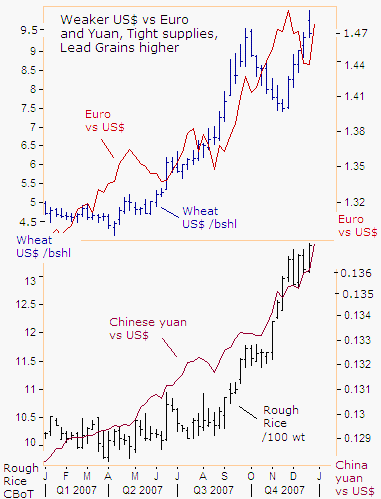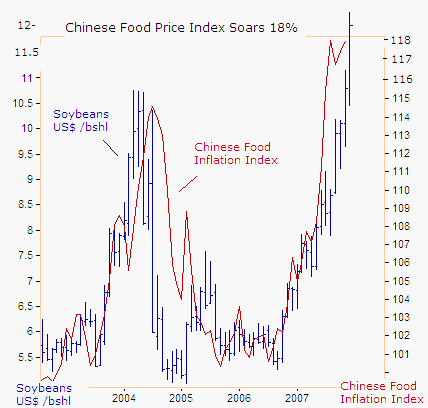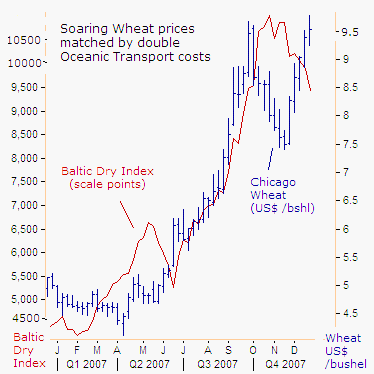|
|||
The "Commodity Super Cycle" - Ready to Rumble in 2008Gary Dorsch "A trend in motion, will stay in motion, until some major outside force, knocks it off its course." After gyrating within a sideways trading range over the past 18-months, the "Commodity Super Cycle," measured by the Dow Jones-AIG Commodity Index, (DJCI), resumed its upward course in the second half or 2007. Led by the agricultural, energy, and precious metal sectors, the DJCI closed at an all-time high. According to famed hedge-fund trader Jimmy Rogers, the 20th century has seen three secular bull-markets in commodities from 1906-1923, and from 1933-1955, and 1968-1982, spanning an average of 15-years. The current bull market for the DJCI is now six-years old, and Mr Rodgers thinks the "Commodity Super Cycle" has many more years to run, albeit with some nasty corrections along the way. The latest commodities boom began at the end of 2001, when China's industrial revolution was just starting. China's voracious appetite for raw materials for its industrialization has made it the #1 consumer of copper, steel, and iron ore in the world, consuming more of theses metals than the United States and Japan combined, and ranking #2 in consumption of oil and energy products. And China's population of 1.3 billion has become the world's #1 consumer of soybeans. Evidence of an impressive bull-run is stacking up, with crude oil surging 60% to $96 per barrel in 2007, and tripling since late 2003. Platinum climbed 34% to an all-time record high of $1,550 /oz, and if the world's 500 million cars were fitted with fuel cells, the world's platinum supply would be exhausted in 15-years. Copper was a laggard, with a 10% gain, but is still five times higher since 2003, hitting a record $8,800 /ton in 2006, while lead and tin are now at historic highs.  Agricultural commodities joined the party in 2007, with wheat futures in Chicago climbing +77%, as global demand outpaced supply, soybeans up +79%, corn up +16%, and rice futures were up +35 percent. A weaker US dollar makes American grain prices less expensive to buyers abroad, and US wheat exporters already have sold more than 90% of the 1.18 billion bushels the US Department of Agriculture expects will be exported during the whole marketing year, which ends in June 2008. Rough rice futures in Chicago soared to all-time highs, led by strong export demand and weather-related Asian crop shortages in India, the world's second-largest rice exporter, and in Vietnam, the third-largest shipper. Global rice supplies fell 6.5% in the fourth quarter alone to 72.1 million tons, and according to latest estimates, supplies are headed down to 50 million tons, the lowest level since 1983-84. Food prices are 18% higher in China from a year ago, and the Communist kingpins in Beijing, fear that runaway inflation could ignite social unrest. The price of pork, which forms the core of most Chinese diets, was up a staggering 56%. "We're facing a grave situation," said Ma Kai, the country's top planner. China has a fifth of the world's population, with 1.3 billion people using 7% of the world's farmland.  Zheng Guogan, head of the State Meteorological Administration forecasts global warming will cut China's annual grain harvest by up to 10 percent. That would mean about 50 million tons less grain in the current tight supply situation and a potential for further food inflation in world markets. "Given the tightened food supply in the international market, a decline in domestic grain production could lead to more price hikes," said Song Tingmin, VP of the China National Association of Grain. The US Department of Agriculture has also cut its estimate of world wheat stocks for 2007-08 to 112.4 million tons, a 30-year low. If sustained, sharply higher wheat prices will eventually work their way into the grocery aisle for bread, cereal, cookies and other products. Fearing a further rise in prices, India, Pakistan, Egypt, Morocco, Algeria, Indonesia and Iraq have all booked large cargoes of wheat. And it's not just the Fed's weak US dollar policy that is driving up agricultural prices to record highs these days. Growing Bio-fuel demand has pushed up corn and soybean prices, and creating a linkage with crude oil. Furthermore, the cost of transporting dry goods such as coal, iron ore, and grains overseas, as measured by the Baltic Dry Index, have doubled from a year ago. Higher transportations costs, by land or by sea, are expected to be eventually passed along to the final consumer. Riding on the wings of the "Commodity Super Cycle" and global inflation was the glittering Gold market, up 32% in 2007. Gold was energized by reckless central bankers and the explosive growth of the world's money supply. In Australia, the M3 money supply rose 20.7% from a year ago, Brazil's M3 +17%, Canada's M3 +12.9%, China's M2 +18.5%, the Euro zone's M3 +12.3%, Hong Kong's M3 +31.5%, India's M3 +21.5%, and the USA's M3 +15.8%, a 47-year high. Chinese and Indian Imports fuel "Commodity Super Cycle" Maybe, the longevity of the "Commodity Super Cycle," boils down to one simple equation. According to the latest population count by the United Nations, the world had 6.5 billion inhabitants in 2005, 380 million more than in 2000, or an annual gain of 76 million persons. By 2050, the world is expected to house 9.1 billion persons, assuming declining fertility rates. So a world of finite raw materials, along with an increasing population base, translates into higher commodity prices. China and India house one-third of the world's population with 2.3 billion inhabitants.  In an ironic twist, China has become a victim of its own phenomenal success. China's economy expanded at a blistering 11.5% last year, but was plagued with a 7% inflation rate, largely linked to the country's voracious appetite for global commodities. China's imports climbed 20.5% to $865.5 billion in the first 11-months of 2007, from the year earlier period, and Chinese demand effectively put a floor under the DJCI, whenever panicky commodity traders in London, New York, Tokyo, or Shanghai got the urge to turn paper profits into cash. To read the rest of this article, please click on the link below: http://sirchartsalot.com/article.php?id=75 Jan 2, 2008 |
